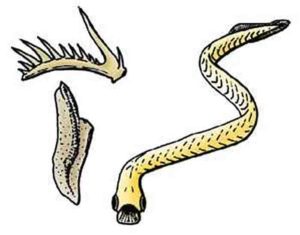
The earliest predators appeared on Earth 480 million years ago—and they even had teeth capable of repairing themselves. A team of palaeontologists led by Bryan Shirley and Madleen Grohganz from the Chair for Palaeoenviromental Research at Friedrich-Alexander-Universität Erlangen-Nürnberg (FAU) have discovered more about how these organisms were able to grow and regenerate their teeth. The results have now been published in Proceedings of the Royal Society B.
Millions of years ago: A fast-moving predator with sharp teeth goes hunting in the prehistoric sea. It spies prey and advances stealthily. It goes in for the kill and devours its prey. Some of the predator’s teeth break, but they will grow back.
This is a description of a conodont. Although these eel-like vertebrates were only a few centimetres long, they are considered the Earth’s first predators. Their small teeth, which are among the most important microfossils, could repair themselves after being damaged. How, exactly, this happened is difficult to ascertain—although the fossilised teeth are often found in marine rock, their soft tissue is only rarely preserved. Since only a few examples of soft tissue from conodonts have survived, it is very difficult to determine how they grew.
Analyses carried out by FAU researchers are now shedding more light on the subject. By using electron microscopes, the scientists examined the layers of conodont teeth to learn more about how they grew. During this scanning process, a material is bombarded with electrons. Different materials reflect a different number of electrons back to the microscope. For example, heavy elements reflect electrons more strongly than lighter ones, which is why they are shown in a lighter colour on the image. This method enabled researchers to reproduce the individual layers and investigate them at a much higher resolution than before.
By using X-ray spectroscopy, in which elements are detected by means of the the radiation they emit, the scientists were also able to analyse the chemical composition of each layer.
The teeth grew in an alternating cycle between wear and the growth of new layers. Furthermore, the shape of the teeth varied greatly depending on the animals’ stage of growth. Using the chemical composition and the shape of the teeth, the researchers were able to identify three stages of growth during the development of an animal that were influenced (amongst others) by feeding habits. After the first stage, a type of larval state, in which food was not digested mechanically (by chewing), conodonts evolved into the first hunters during the second and third stages of growth. During this time, their teeth underwent a metamorphosis as they evolved into predators.
Up to now, there have been two models to explain how conodont teeth were able to regenerate themselves. In contrast to human teeth, for example, which grow from the inside out, conodonts’ teeth repaired themselves from the outside, continuously adding new layers. One theory developed by scientists is that conodonts retracted their teeth during periods of rest, and the apposition of new layers in epidermal pockets induced growth. This could be compared to the mechanism of retractable teeth used for injecting venom by some species of snake. On the other hand, another theory suggests that the teeth were permanently enveloped by tissue and a type of horn cap, allowing new layers to build up over time. The research carried out by FAU scientists has now confirmed the first theory.
The results of the research have been published under the title “Wear, tear and systematic repair: testing models of growth dynamics in conodonts with high-resolution imaging” in the journal Proceedings of the Royal Society B.
Reference:
Bryan Shirley et al, Wear, tear and systematic repair: testing models of growth dynamics in conodonts with high-resolution imaging, Proceedings of the Royal Society B: Biological Sciences (2018). DOI: 10.1098/rspb.2018.1614
Note: The above post is reprinted from materials provided by University of Erlangen-Nuremberg.










